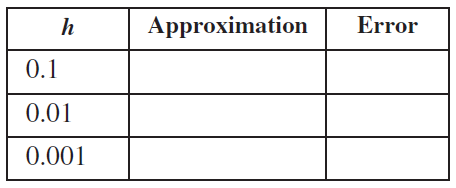Assuming the limit exists, the definition of the derivative If h > 0, then this approximation is
Question:
Assuming the limit exists, the definition of the derivative

implies that if h is small, then an approximation to f'(a) is given by

If h > 0, then this approximation is called a forward difference quotient; if h < 0, it is a backward difference quotient. As shown in the following exercises, these formulas are used to approximate f' at a point when f is a complicated function or when f is represented by a set of data points.
Another way to approximate derivatives is to use the centered difference quotient:

Again, consider f(x) = √x.
a. Graph f near the point (4, 2) and let h = 1/2 in the centered difference quotient. Draw the line whose slope is computed by the centered difference quotient and explain why the centered difference quotient approximates f'(4).
b. Use the centered difference quotient to approximate f'(4) by completing the following table.

c. Explain why it is not necessary to use negative values of h in the table in part (b).
d. Compare the accuracy of the derivative estimates in part (b) with those found in Exercise 64.
Data from Exercise 64
Assuming the limit exists, the definition of the derivative

implies that if h is small, then an approximation to f'(a) is given by

If h > 0, then this approximation is called a forward difference quotient; if h < 0, it is a backward difference quotient. As shown in the following exercises, these formulas are used to approximate f' at a point when f is a complicated function or when f is represented by a set of data points.
Let f(x) = √x.
Step by Step Answer:

Calculus Early Transcendentals
ISBN: 978-0321947345
2nd edition
Authors: William L. Briggs, Lyle Cochran, Bernard Gillett





